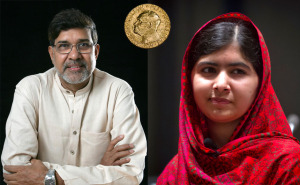by: Liana DeMasi
Recently the Norwegian Nobel Committee announced that Malala Yousafzai and Kailash Satyarthi would be the winners of the Nobel Peace Prize. Both Malala and Satyarthi were chosen due to their dedication to ending the suppression of children and campaigning for equal education among the sexes.
Malala, from Pakistan, is the youngest winner of the Nobel Peace Prize at 17 years old. At the age of 11 she began advocating for the education of girls and women, something that is rare in areas like the tribal, Taliban-run area of Pakistan where Malala is from. At the age of 15 she was shot in the head by Taliban gunmen because she insisted that girls have just as much of a right to an education as boys. Miraculously, she survived the injuries due to several operations done in Britain, and after her recovery, she continued to advocate regardless of the imminent threat on her life.
Satyarthi, a 60-year-old man from India, won due to his advocacy for an end to child labor and slavery. He is being compared to Mahatma Gandhi because he too is known for peaceful demonstrations and protests. Like Malala, he also experienced many attempts on his life but despite this, he says, “I will see the end of child labor in my life”.
These chosen winners are very important for another reason: they unite two opposites. Pakistan and India are bitter rivals and Malala is Muslim while Satyarthi is Hindu. This shows that two people, from two very different backgrounds, can unite to fight a similar cause. It goes to show how easy peace is to obtain if only we could learn to put aside our differences.

